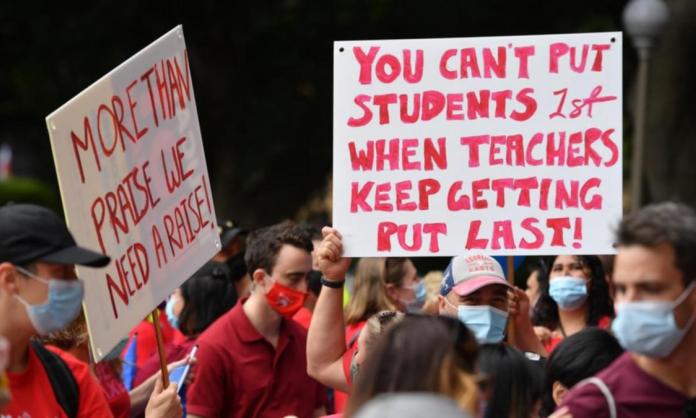Australia’s teacher shortage is becoming increasingly desperate. Some schools have resorted to offering sign-on bonuses of up to $10,000 to attract staff—money that will have to be offset with cuts in other areas.
The haemorrhaging of staff is causing the number of vacancies to grow to unprecedented levels. In Victoria alone, at the start of August, there were 2,255 vacancies posted on the Department of Education website, more than double the number in January. By the end of the month there were 2,543. This makes the federal government’s prediction of a shortfall of 4,000 teachers nationally by 2025 look conservative.
Many of the vacancies are concentrated in disadvantaged schools where students have more complex needs, leaving them with even less support. Government schools have long been underfunded compared to non-government schools, and the gap is widening. Parliamentary library data provided to the Guardian shows that real funding to private schools has increased almost twice as much as funding to public schools in the last decade.
At the heart of the crisis are teachers’ unmanageable workloads. A 2022 survey of almost 5,500 teachers by researchers at Monash University found that “workload and associated concepts such as burnout, work-life balance and exhaustion were the most common reasons for teachers’ intention to leave their careers”. The workforce hangs by a thread, with up to 70 percent of teachers considering quitting.
When asked why they wanted to leave, respondents reported that teaching “is too stressful, the expectations are so high, you are not paid for the hours you work, [and] you are overworked which isn’t healthy”. According to a 2022 Grattan Institute report, “more than 90 per cent of teachers say they don’t have enough time to prepare effectively for classroom teaching”. A 2021 survey by the Australian Education Union found teachers were working an average of 53 hours a week, 15 more than they are paid for.
Without extra time to manage growing class sizes, challenging student behaviour, pressure from parents and principals, extra administrative work and the never-ending curricula reviews, teachers are burning out. Many are moving to less stressful and often better paying roles in different industries. Those who stay are forced to pick up the slack.
Labor could stop this vicious cycle if it wanted. It could pour funding into public schools, lift teachers’ and education support staff wages, hire thousands of additional teachers and support staff to reduce workloads and give staff more planning days. The main obstacle is that this doesn’t fit with the party’s political priorities. Labor would rather spend hundreds of billions on nuclear submarines and tax cuts for the wealthy than support our schools.
Instead of any genuine support for the public education system, Labor’s response has overwhelmingly focused on pushing more teachers into the meat grinder. Programs like Permission to Teach, Teach Today, Teach Tomorrow, and Teach for Australia push unqualified professionals and teaching students into schools in priority areas before they’ve completed appropriate training.
This undermines the professional status of teachers, devalues their qualifications and will contribute to the burnout that many teaching students experience even before they graduate—the result of juggling work and study simultaneously. According to the Australian Institute for Teaching and School Leadership (AITSL), the completion rate for initial teacher education (ITE) is as low as 50 percent. Still, Labor refuses to make ITE free and ensure all students are paid while on placement.
By focusing on the supply-side recruitment of teachers, Labor is obscuring the source of shortages rather than fixing them. Who cares how many teachers you recruit when, according to AITSL, up to 50 percent of them are likely to quit in their first five years on the job? Any attempts to patch up vacancies without addressing working conditions will fail. A strategy that seriously addressed teachers’ concerns would likely boost both recruitment and retention.
But don’t bet on Labor’s Minister for Education Jason Clare to deliver something as sensible as that. His latest scheme, the National Teacher Workforce Action Plan, will do nothing significant to ease workloads. It will invest $328 million over nine years, a pitiful $36 million a year, with only just over $3 million a year going to a “Teacher Workload Reduction Fund”. The majority of the funding will go towards increasing teacher supply—shovelling more teachers into the same hellish conditions.
Another important part of Clare’s strategy is to blame universities for not preparing teachers properly. They will be required to overhaul their ITE programs in the next two years. Scapegoating the universities allows Clare to continue neglecting the thorny issues of teachers’ pay and conditions. It also conveniently implies that teachers are quitting in droves not because of any failure on the part of the government but because teachers themselves are not capable enough. It’s another way of blaming teachers without saying as much.
In June, the Australian Financial Review published an editorial titled “Courageous Clare’s plan to stop Australia’s great schooling rot”. It’s no surprise Clare has earned such high praise from the ruling-class propagandists at the AFR. They want to see education funding kept low, teachers’ professional status undermined and the crisis in schools blamed on teachers’ supposed failures. By those standards, Clare gets a high distinction.








